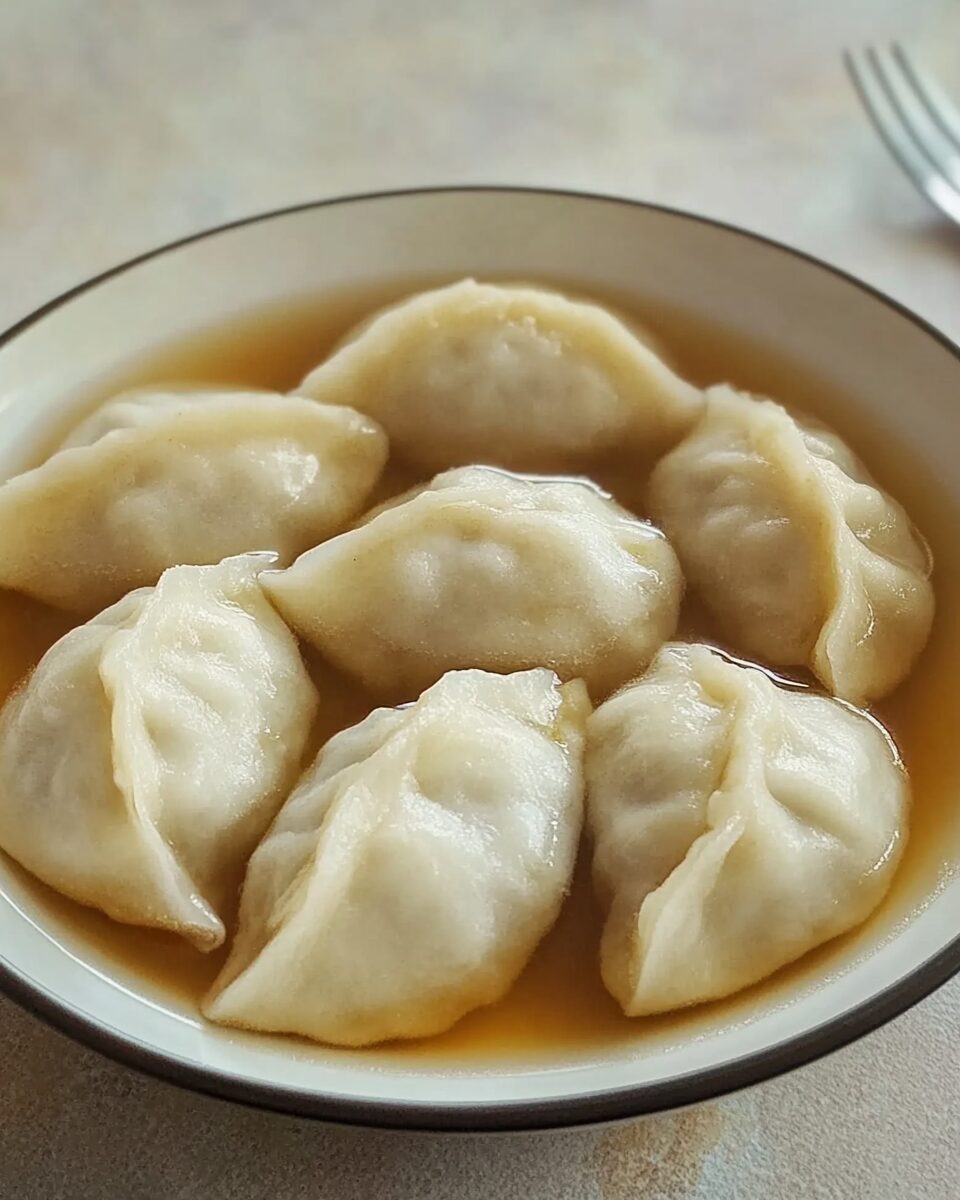These light and fluffy dumplings bring comfort food to the next level with their tender, melt-in-your-mouth texture. Perfectly paired with hearty stews or soups, they are a timeless addition to any kitchen repertoire.
Whether you’re looking to recreate a childhood favorite or seeking a quick, homemade meal to warm your soul, these dumplings deliver on all fronts. With just a few pantry staples and less than 30 minutes, you can create a dish that feels like a warm hug in every bite.
Full Recipe:
- 1 cup all-purpose flour
- 2 teaspoons baking powder
- 1 teaspoon white sugar
- 1/2 teaspoon salt
- 2 tablespoons cold butter or margarine
- 1/2 cup whole milk
Directions:
- In a medium mixing bowl, combine flour, baking powder, sugar, and salt.
- Cut cold butter or margarine into the flour mixture using a pastry cutter or two forks until it resembles coarse crumbs.
- Gradually stir in milk to form a soft dough.
- Drop spoonfuls of dough directly onto the surface of a simmering stew or soup.
- Cover and simmer on low heat for 10–12 minutes. Do not uncover while cooking to ensure the dumplings steam properly.
- Check for doneness by inserting a toothpick into a dumpling. If it comes out clean, they are ready to serve.
Prep Time: 10 minutes | Cooking Time: 12 minutes | Total Time: 22 minutes
Kcal: 155 kcal | Servings: 4 servings
The Comforting Appeal of Homemade Dumplings
Dumplings hold a special place in the hearts of many food enthusiasts. They represent more than just a meal; they symbolize comfort, tradition, and the simplicity of home cooking. This classic dish has traveled through generations, with families across the globe putting their unique spins on the recipe. The dumpling’s beauty lies in its versatility—it can be boiled, steamed, baked, or fried, adapting to cultures and cuisines while retaining its signature charm.
In the U.S., dumplings are most commonly associated with dishes like chicken and dumplings, a comforting stew that combines tender meat, hearty vegetables, and fluffy dough. However, this dish’s origins span much further, rooted in culinary traditions that stretch back centuries.
A Brief History of Dumplings
The history of dumplings is as diverse as the recipe itself. Different variations can be found worldwide, from Chinese dumplings filled with pork and cabbage to Polish pierogi stuffed with potatoes and cheese. The version popular in American cuisine—soft, pillowy dumplings floating atop broth—evolved from early European settlers’ recipes. These pioneers created dumplings with simple ingredients they had on hand, transforming them into a staple of hearty, filling meals.
In particular, the Southern United States has embraced dumplings, incorporating them into iconic dishes like chicken and dumplings. This preparation reflects the region’s focus on rustic, soulful cooking that celebrates both practicality and indulgence.
The Science Behind Perfect Dumplings
At first glance, dumplings may appear deceptively simple. However, creating the perfect texture—a delicate balance between light and fluffy yet sturdy enough to hold together—requires a little finesse. The key is the balance of leavening agents and mixing techniques.
Baking powder serves as the essential leavening agent in many dumpling recipes, releasing gas that causes the dough to rise as it cooks. This ensures a soft and airy texture. Overmixing the dough, however, can lead to dense dumplings due to excessive gluten development. The secret lies in gently combining the ingredients until just incorporated.
Butter or margarine also plays a pivotal role. When cut into the flour, it creates small pockets that melt during cooking, contributing to a tender bite. Meanwhile, milk adds moisture, binding the ingredients into a cohesive dough. These pantry staples work harmoniously to create dumplings that are as satisfying to eat as they are to make.
Dumplings in Comfort Food Culture
Dumplings have long been celebrated as the ultimate comfort food. Whether served in a savory chicken stew or alongside rich vegetable broths, their hearty texture and flavor evoke memories of cozy kitchens and family meals. There’s something inherently nostalgic about a steaming bowl of dumplings—it’s the culinary equivalent of a warm blanket on a cold day.
The dish’s association with comfort stems from its affordability and simplicity. During difficult times, dumplings offered a way to stretch a meal, adding bulk and substance to broths or stews. Despite their humble beginnings, dumplings have endured as a beloved dish, providing a sense of warmth and security in every bite.
Creative Variations to Explore
While traditional dumplings are undeniably delicious, there are countless ways to experiment with the recipe. Here are a few ideas for adding your own twist to this classic dish:
- Herb-Infused Dumplings: Incorporate fresh herbs like parsley, thyme, or chives into the dough for a burst of flavor.
- Cheesy Dumplings: Mix grated Parmesan or cheddar into the batter for a rich, cheesy profile that pairs wonderfully with tomato-based soups.
- Whole-Grain Dumplings: Substitute part of the all-purpose flour with whole wheat flour for a nuttier flavor and added fiber.
- Spiced Dumplings: Add a pinch of garlic powder, paprika, or black pepper for a more robust taste that complements hearty stews.
- Vegan Dumplings: Use plant-based butter and a non-dairy milk alternative like almond or soy milk to make the recipe vegan-friendly.
These variations demonstrate the dumpling’s adaptability, allowing cooks to tailor the recipe to their preferences or dietary needs.
Dumplings Across the World
While American-style drop dumplings are celebrated for their simplicity, dumpling variations abound in international cuisine. Each culture has embraced this doughy delight, showcasing its versatility and universal appeal.
- China: Dumplings such as jiaozi or xiao long bao are often filled with meat, seafood, or vegetables and served with soy-based dipping sauces.
- Italy: Gnocchi, a potato-based dumpling, is paired with rich tomato or creamy sauces, offering a comforting dish with a European flair.
- Poland: Pierogi are dough pockets filled with a variety of ingredients, from mashed potatoes to sweet fruits, reflecting the country’s culinary creativity.
- Korea: Mandu, often stuffed with kimchi or pork, is a Korean take on dumplings, steamed or fried for a delightful texture.
Each of these styles highlights the dumpling’s ability to transcend borders, becoming a culinary favorite worldwide.
Tips for Serving Dumplings
While dumplings are a star in their own right, they shine even brighter when paired with the right accompaniments. Here are some tips for serving them:
- Pair with a Flavorful Broth: Dumplings absorb the flavors of the broth they cook in, so opt for a rich, well-seasoned base.
- Add Fresh Garnishes: Chopped herbs, a dollop of sour cream, or a drizzle of infused oils can elevate the dish.
- Serve with a Side Salad: A crisp, tangy salad can provide a refreshing contrast to the dumplings’ hearty texture.
Presentation matters too! Serving dumplings in a rustic bowl with a ladle of steaming broth creates a visually appealing and inviting dish.
The Joy of Making Dumplings from Scratch
In today’s fast-paced world, making dumplings from scratch is a rewarding endeavor. The process of mixing, shaping, and cooking the dough offers a sense of mindfulness and accomplishment. It’s an activity that brings families together, with each member contributing to the meal preparation.
For beginner cooks, dumplings are an excellent introduction to homemade recipes. They require minimal ingredients, are forgiving in their preparation, and deliver satisfying results. For seasoned chefs, they offer endless opportunities to experiment with flavors and textures.
Conclusion: A Dish for Every Occasion
Homemade dumplings are more than just a recipe—they’re an experience. Whether served in a rich chicken stew on a cold winter evening or as a quick addition to a weeknight meal, dumplings bring comfort and joy to the table. Their adaptability and ease of preparation make them a go-to dish for both novice and expert cooks.
By experimenting with variations and pairing them with complementary sides, you can create a unique culinary experience every time. So, roll up your sleeves, gather a few simple ingredients, and enjoy the timeless pleasure of homemade dumplings. It’s a tradition worth savoring and sharing.

